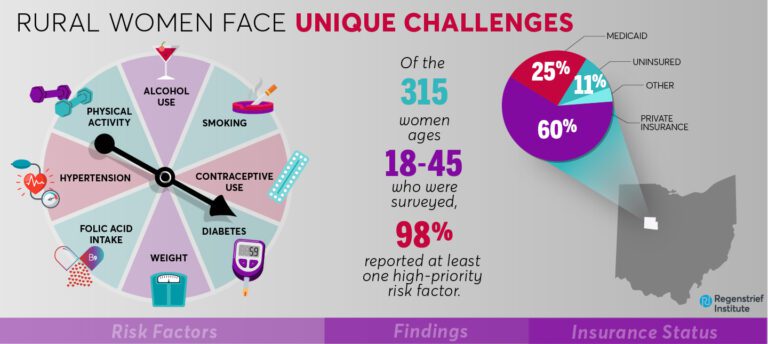The study highlights the importance of targeted health funding for rural communities
A study by the Regenstrief Institute and Indiana University School of Public Health researchers Richard M. Fairbanks is one of the first to provide insight into the health and behaviors of reproductive-age women in the rural Midwest before and between pregnancies. This population is at risk for poor health and pregnancy outcomes, but is typically underrepresented in national, state, and other public health studies.
The study revealed both poor preconception and poor health status among rural women. An estimated 18 million women of reproductive age live in rural areas of the US
About 98 percent of the 315 rural women surveyed by the researchers reported at least one high-priority risk factor related to smoking, hypertension, diabetes, alcohol use, folic acid intake, weight, physical activity or the use of contraceptives.
These women, who resided in northwest Ohio, fared worse than those in the state overall on smoking, folate intake, weight, and hypertension, making rural women more vulnerable to poor pregnancy outcomes and at higher risk for worse overall health outcomes, such as diabetes. , obesity and cancer.
Although survey responses indicated that most study participants did not meet the threshold for heavy alcohol use, nearly a third reported recent binge drinking episodes.
“Our findings highlight some of the differences between rural and other women in Ohio that may reflect a bias toward urban populations,” said Regenstrief and Fairbanks School researcher Brian Dixon, PhD, MPA, senior author of the study. “This means that if we're thinking about how to reduce cancer rates and how to address the health of these women and their children's exposure to secondhand smoke, we need to put more resources into rural-level smoking cessation programs.”
The study was conducted in Hardin County, a rural county of 470 square miles with a total population of 31,480 and a shortage of health professionals. Kenton, the county's largest city, has a population of less than 8,000.
Survey responses were collected from women in several locations throughout the county. The ages ranged from 18 to 45 and they were not pregnant. About 96 percent were White, according to county demographics. Three quarters had one or more children. About 60 percent had private health insurance, and nearly a quarter were eligible for Medicaid. About 11 percent had no health insurance.
“State estimates are often used to monitor preconception and interconception health status for women of reproductive age. However, this may not reflect the true health status for women living in rural or underserved areas,” said Natalie DiPietro Mager, PharmD, PhD, the study's first author, who teaches at Ohio Northern University. “The findings of this study show that we need better methods of collecting and reporting data on women in these areas so that needed interventions can be identified.”
The findings of this study can be used for monitoring, comparison and benchmarking.
The authors note that the study “identified significant health risks that should be prioritized and addressed through clinical and public health interventions that represent the unique challenges facing rural women.” They note that “their findings highlight the importance of targeted funding for rural communities to improve the health of residents and reduce health inequities.”
“Preconception health status and associated disparities among rural, midwestern women in the United States” is published in the peer-reviewed journal Birth: Issues in Perinatal Care.
The authors of the study, as listed in the publication
Natalie A DiPietro Mager 1,6Terrell W Zollinger 1Jack E Turman Jr 2 3Jianjun Zhang 1 4Brian E Dixon 1 5
Partnerships, as listed in the publication
1Department of Epidemiology, Indiana University Richard M. Fairbanks School of Public Health, Indianapolis, Indiana, USA.
2Department of Social and Behavioral Sciences, Indiana University Richard M. Fairbanks School of Public Health, Indianapolis, Indiana, USA.
3Department of Pediatrics, Indiana University School of Medicine, Indianapolis, Indiana, USA.
4Indiana University Melvin and Bren Simon Comprehensive Cancer Center, Indianapolis, Indiana, USA.
5Center for Biomedical Informatics, Regenstrief Institute, Inc., Indianapolis, Indiana, USA.
6Ohio Northern University, Raabe College of Pharmacy, Ada, Ohio, USA.
About Brian E. Dixon, PhD, MPA
In addition to his roles as interim director of the Regenstrief Institute's Clem McDonald Center for Biomedical Informatics and director of public health informatics for the Regenstrief Institute and the Indiana University Richard M. Fairbanks School of Public Health, Brian E. Dixon, PhD, MPA, is a professor of epidemiology at the Fairbanks School of Public Health. He is also an associate scientist at the US Department of Veterans Affairs Health Services Research and Development Center for Health Information and Communication, Richard L. Roudebush VA Medical Center.
About the Regenstrief Institute
The Regenstrief Institute, founded in 1969 in Indianapolis, is a local, national and global leader dedicated to a world where better information empowers people to end disease and realize true health. A key research partner of Indiana University, Regenstrief and its researchers are responsible for a growing number of important health innovations and studies. Examples range from developing global health information technology standards that enable the use and interoperability of electronic health records to improving patient-physician communication to creating models of care that inform practice and improve the lives of patients around the world .
Sam Regenstrief, a nationally successful businessman from Connersville, Indiana, founded the institute with the goal of making health care more efficient and accessible for all. His vision continues to guide the institute's research mission.
About the IU Richard M. Fairbanks School of Public Health
Located on the IUPUI and Fort Wayne campuses, the IU Richard M. Fairbanks School of Public Health is committed to advancing the health and well-being of the public through education, innovation and leadership. The Fairbanks School of Public Health is known for its expertise in biostatistics, epidemiology, cancer research, community health, environmental public health, global health, health policy and health services management.

